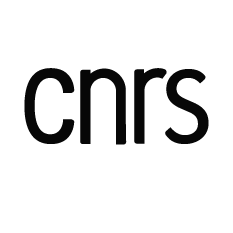Materials for Nuclear
Scientific manager:
Technical manager:
Presentation
The technical facility ‘Nuclear Materials’ offers possibilities for the synthesis of uranium compounds, as well as their preparation for analysis: precipitation, calcination, drying, melting, pelleting, sintering, cutting, polishing, liquid-solid separation (filtration and/or centrifugation) and sieving.
Accessible to all researchers who have received training from the Radiation Safety Officer, the platform also offers academic collaborations and long-term partnerships with industrial companies. The possibility of handling certain radioelements (uranium and thorium) makes achievable study about the nuclear fuel cycle.
For the laboratory's researchers, it is also possible to use certain equipment themselves after following individual or group training.
Remarkable equipment
![[Translate to English:] Photo hotte à flux laminaire](/fileadmin/_processed_/6/c/csm_Hotte_a_flux_laminaire_9061d4cb62.jpg)
Cyto Fast Elite 218 laminar flow hoods
Our two Cyto Fast Elite 218 laminar flow hoods are designed to ensure personnel and environmental protection during the handling of radioactive powders. Three HEPA filters are installed in these hoods, effectively containing the powders inside.
![[Translate to English:] Photo Boite à gants Jacomex GP campus](/fileadmin/_processed_/6/6/csm_Boites_a_gants_Jacomex_GP_campus_e113d04e8c.png)
Jacomex GP Campus glove boxes
Two Jacomex GP Campus glove boxes are available in the facility. These boxes are filled with argon and are used to isolate radioactive elements from the ambient air, to store materials, or to prepare samples for analysis. They are equipped with a balance and a hydraulic press for making pellets.
![[Translate to English:] Centrifugeuse Thermoscientific Sorvall ST16](/fileadmin/_processed_/3/7/csm_Centrifugeuse_Thermoscientific_Sorvall_ST16_de44857224.png)
Thermoscientific Sorvall® ST16 centrifuge
The facility is equipped for powder synthesis by precipitation. Once precipitated, the powder can be separated from the liquid phase by filtration or centrifugation. The Thermoscientific Sorvall® ST16 centrifuge is equipped with holders for centrifuge tubes ranging from a few milliliters to a few hundred milliliters.
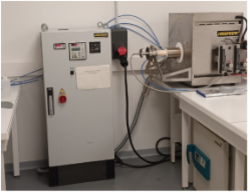
Nabertherm tubular furnace
Some syntheses require a thermal treatment step, for which the facility is equipped with a set of furnaces (capable of operating under different atmospheres: air, argon, argon-hydrogen) and ovens.
- 2 'Eraly' tubular furnaces (Maximum temperature: 1100°C)
- 'Eraly' well-type tubular furnace (Maximum temperature: 1100°C)
- 'Nabertherm' muffle furnace (Maximum temperature: 1150°C)
- 'Nabertherm' tubular furnace (Maximum temperature: 1750°C)
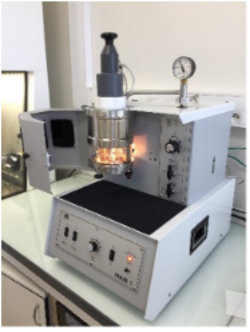
E. Bühler Gmbh MAM arc furnace
The electric arc furnace is used in metallurgy to melt metals. An electric arc is created in a chamber containing the raw materials to be melted. The resulting arc ingots can then be analyzed directly or undergo further heat treatment.
The facility is equipped with an E. Bühler Gmbh MAM electric arc furnace capable of melting alloys with or without radioactive elements.
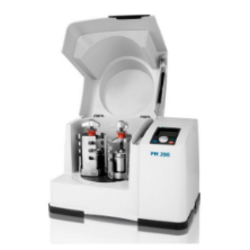
Retsch PM100 planetary mill
Planetary milling is used to mix powders, fragment materials, homogenize emulsions and pastes, obtain new materials through mechano-synthesis, and enhance the reactivity of a given powder or material for a specific application.
The Retsch PM100 planetary mill available in the facility is dedicated to processing samples containing uranium or thorium.
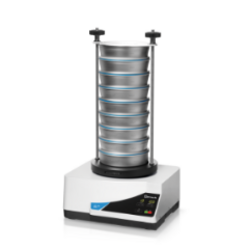
Retsch AS200 basic sieve shaker
Sieving is used to separate solid particles based on their dimensions.
The facility is equipped with a Retsch AS200 basic sieve shaker and sieves with opening diameters ranging from 63 µm to 2500 µm.
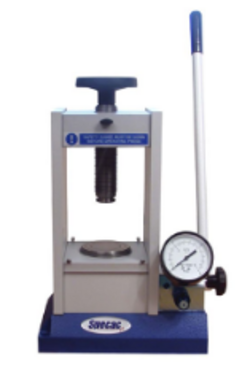
Specac manual hydraulic press
The facility is equipped with two Specac manual hydraulic presses, one operated under ambient air conditions and the other inside a glove box. These presses are used to shape powders into pellets with diameters of 8 or 10 mm.
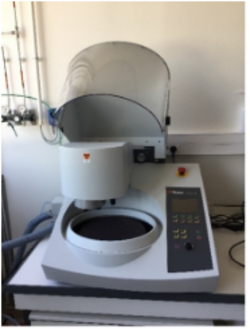
Struers Tegramin 30 polisher
In order to perform certain surface analyses (optical, electron microscopy), polishing is necessary. The facility is equipped with a Struers Tegramin 30 polisher capable of surface treatment for radioactive materials (bulk pieces or coated powders).
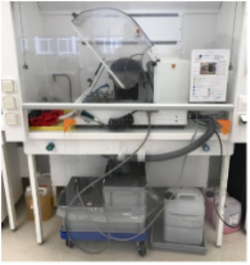
Lamplan Cutlam® Micro 3.0 diamond saw
In order to obtain a piece with specific dimensions, whether for producing thin slices or adjusting the size of a sample to fit the dimensions of the analysis device, the facility is equipped with a diamond disc saw, Lamplan Cutlam® Micro 3.0. The range of blades allows cutting various materials, including metallic uranium.
![[Translate to English:] Binoculaire motic smz 168](/fileadmin/_processed_/6/1/csm_Binoculaire_motic_smz_168_3ec15412ee.png)
Motic SMZ 168 binocular microscope
For observing the surface condition of materials or coatings, as well as for examining the particles composing powders, the facility is equipped with a Motic SMZ 168 binocular microscope.
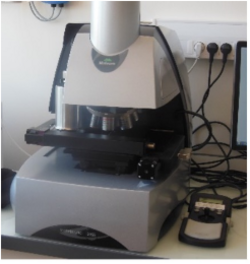
Malvern G3SE Morphogranulometer
The facility is equipped with a Malvern G3SE Morphogranulometer. This tool allows for the characterization of particles to determine their morphological (shape) or granulometric (size) properties.
The powder can be analyzed in the form of a solid or a suspension. The particle size can range from 1 µm to a few mm. Characterization is done through optical detection. The morphogranulometer analyzes the particles of a sample separately, then pixelates the images, allowing each particle to be characterized by its shape or dimensions. Particle classes can then be formed by grouping particles of similar morphology (or close shape), or particles of the same size. This analysis allows for quantifying the different populations within a sample.
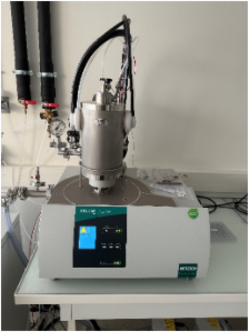
NETZSCH STA 449 F3 Jupiter® Simultaneous Thermal Analyzer (STA)
The facility is equipped with a modular NETZSCH STA 449 F3 Jupiter® simultaneous thermal analyzer, capable of measuring mass variations and/or thermal effects between -150°C and 2400°C under different atmospheres.
Currently, the simultaneous thermal analyzer is configured as a thermogravimetric analyzer (TGA) and is equipped with a graphite furnace cooled by water, allowing mass variation measurements up to 2000°C under argon atmosphere.
